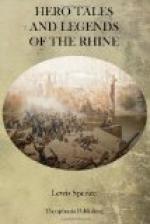Affinity of the Rhine Legends with Romance
But on the whole the legends of the Rhine exhibit much more affinity with medieval romance than with myth or folklore.[1] A large number of them are based upon plots which can be shown to be almost universal, and which occur again and again in French and British story. One of the commonest of these concerns the crusader who, rejected by his lady-love, spends hopeless years in the East, or, having married before setting out for the Orient, returns to find his bride the wife of another. The crusader exercised a strong influence upon the literature of medieval Europe, and that influence we find in a very marked degree in the legends of the Rhine. Again, a number of these tales undoubtedly consist of older materials not necessarily mythical in origin, over which a later medieval colour has been cast. Unhappily many of these beautiful old legends have been greatly marred by the absurd sentimentality of the German writers of the early nineteenth century, and their dramatis personae, instead of exhibiting the characteristics of sturdy medieval German folk, possess the mincing and lackadaisical manners which mark the Franco-German novel of a century ago. This contrasts most ludicrously in many cases with the simple, almost childlike, honesty which is typical of all early Teutonic literature. Had a Charles Lamb, a Leigh Hunt, or an Edgar Allan Poe recast these tales, how different would have been their treatment! Before the time of Schiller and Goethe French models prevailed in German literature. These wizards of the pen recovered the German spirit of mystery, and brought back to their haunts gnomes, kobolds, and water-sprites. But the mischief had been done ere they dawned upon the horizon, and there were other parts of Germany which appeared to them more suitable for literary presentment than the Rhine, save perhaps in drama. Moreover, the inherent sentimentality of the German character, however fitted to bring out the mysterious atmosphere which clings to these legends, has weakened them considerably.
[Footnote 1: See author’s Dictionary of Medieval Romance (London, 1913), preface, and article ‘Romance, Rise and Origin of.’]
The Poetry of the Rhine
Robert Louis Stevenson, exiled in the South Pacific islands, used to speak with passionate fondness of the rivers of his native Scotland, the country he loved so dearly, but which the jealous fates forbade him to visit during fully half his life. Garry and Tummel, Tweed and Tay—he used to think of these as of something almost sacred; while even the name of that insignificant stream, the Water of Leith, sounded on his ear like sweet music, evoking a strangely tender and pathetic emotion. And this emotion, crystallized so beautifully by Stevenson in one of his essays in Memories and Portraits, must have been felt, too, by many other exiles wandering in foreign parts; for surely an analogous feeling has been experienced sometimes by every traveller of




